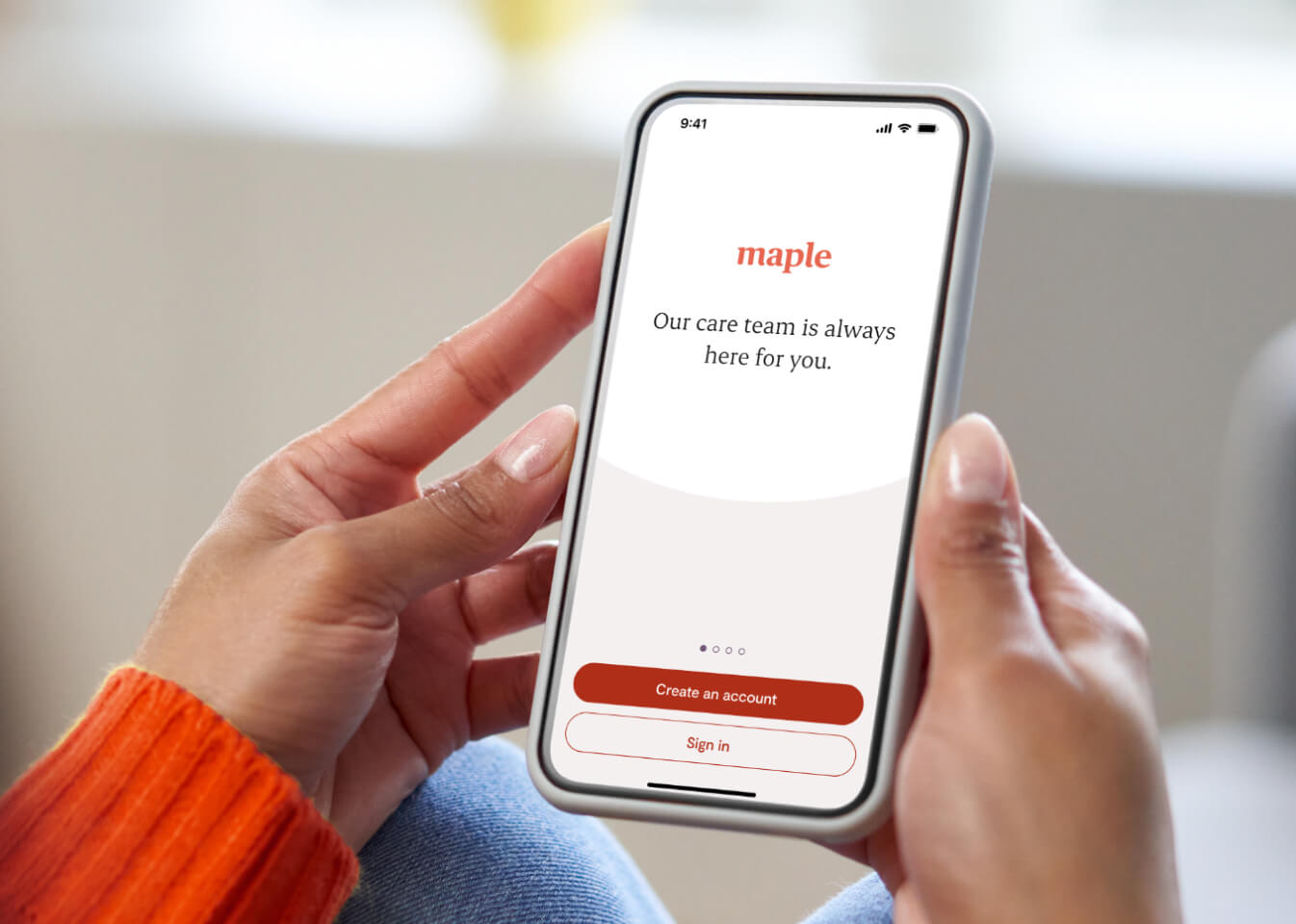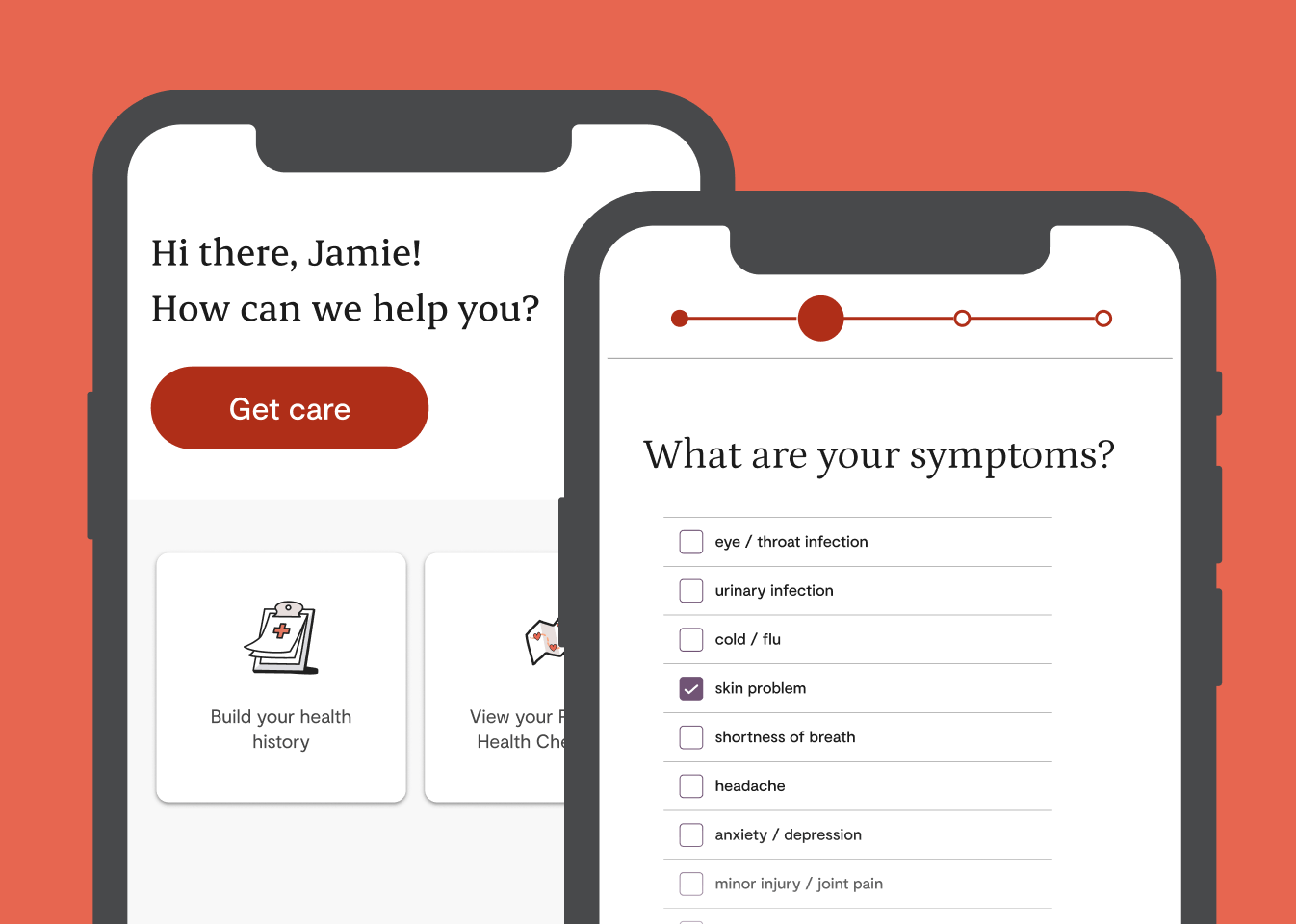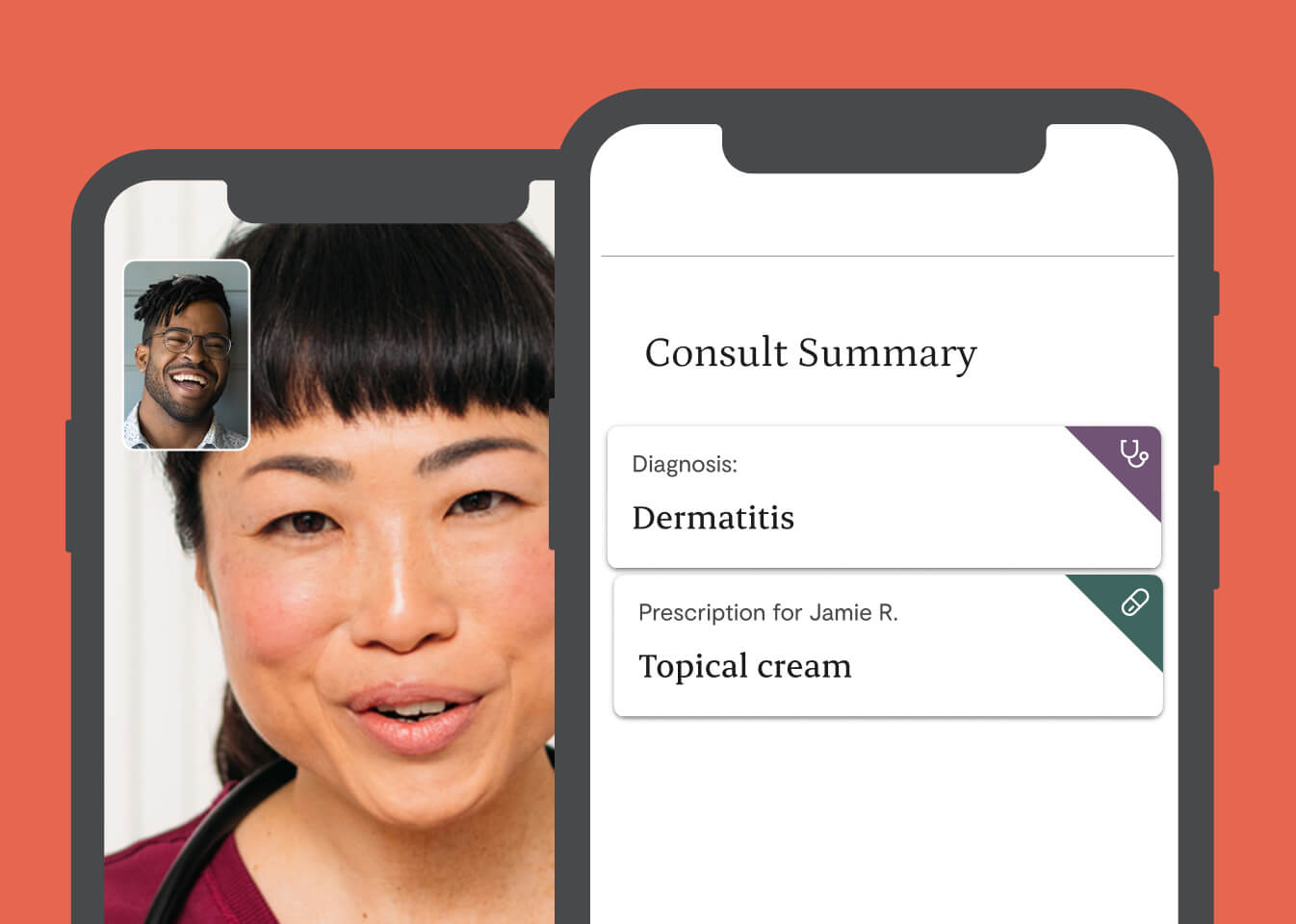Gout treatment, diagnosis & prescriptions
Skip the waiting room! Instantly connect with Canadian doctors for medical care from your phone, tablet or computer - any time, 24/7.

- Prescriptions available at a provider's discretion
- Speak to a doctor or nurse practitioner
- 24/7 availability
- Get connected in minutes
Trusted by millions of Canadians
- 4.8 rating30K+ App Store reviews
- 4.7 score8K+ Trustpilot reviews
Talk to a doctor about gout treatment online
See a doctor or nurse practitioner today to get a new prescription or refill, at their discretion.
See a provider in three easy steps.
- 1
Register and become a member

- 2
Select the “Get care” button on our homepage

- 3
Connect with a Canadian-licensed doctor or nurse practitioner in minutes

Why Canadians love Maple
A fantastic way to get medical advice when you are unable to see someone in person. The app is so simple to use. Highly recommend. I am not a tech savvy person but the doctor was kind enough to patiently walk me through every step of the process. Thank you.
Saved me hours waiting in the ER.
Fast and effective tool for getting a diagnosis and prescription.
The doctor willingly took the time to explain things to me.
Very easy to book a therapist and get appointment receipts.
Frequently asked questions
About Gout
Yes, you can. A healthcare practitioner will want to discuss the symptoms and signs of gout that you’re experiencing, as well as your medical history.
In some cases, the healthcare provider may be able to provide a gout diagnosis based on the symptoms and appearance of the affected area. In others the healthcare practitioner may suggest additional testing to reinforce a gout diagnosis.
Once you have a gout diagnosis, the healthcare provider can suggest appropriate gout treatments based on the severity of the flare-up.
Yes, our physicians can prescribe gout medications online during your consultation. Once you accept a prescription for gout, you’ll have the option to pick it up from any pharmacy or to have it delivered right to your door at no additional cost.
Gout is a common and complex form of arthritis that typically affects joints and soft tissues. Gout is caused by hyperuricemia (excess uric acid in the blood), and deposits of monosodium urate (MSU) crystals in soft tissues, tendons, bursae, and joints.
Most of the time, signs of gout first appear in the big toe (about 50% of initial cases), but gout symptoms can also affect:
- Fingers
- Toes
- Knees
- Midtarsal
- Wrists
- Elbows
- Ankles
This painful condition is becoming more prevalent each year, rising alongside the obesity epidemic that is affecting Canada and the United States.
The symptoms and signs of gout often appear suddenly, and more frequently at night.
The most common gout symptom is intense joint pain at the affected area. The pain is so intense that it wakes you up from just the soft weight of a bed sheet touching the joint. This most frequently occurs in the big toe but can affect other joints. Pain can linger in joints for days or weeks after the most severe symptoms fade.
Another frequently occurring sign of gout is inflammation and redness at the affected area, which may feel warm to the touch.
As it progresses, gout can cause you to lose some of the range of motion in your joints. This is because eventually gout can cause structural changes to joints and periarticular tissues, which can result in chronic gout symptoms.
Directly, gout is caused by a build-up of uric acid in the blood, and deposits of monosodium urate (MSU) crystals in soft tissues and joints. In some cases, it can also affect bursae (fluid-filled sacs surrounding joints), as well as tendons.
Your body produces uric acid and urate crystals by breaking down purines, which is a substance found in certain foods and drinks. It also occurs naturally in the body.
Certain environmental, medical, and lifestyle factors are known to cause gout flare-ups. Some of these include:
- Obesity
- Consuming too many purine-rich foods or drinks (organ meats, red meat, certain types of seafood, and non-diet sodas)
- Consuming excessive amounts of alcohol (particularly beer, gin, whisky, vodka, rum, and wine)
- Overeating, prolonged fasting, or dehydration
- Hypertension (high blood pressure)
- Diabetes or metabolic syndrome
- Heart diseases
- Kidney diseases
- Certain medications (low-dose aspirin, medications for treating hypertension)
- Family history of gout
- Age (men often develop gout between 30 and 50 while women generally develop gout after menopause)
- Recent physical trauma or surgery
A healthcare practitioner will most likely be able to provide a diagnosis for gout by evaluating your symptoms, medical history, and examining the affected area.
In some cases, the healthcare provider may suggest additional testing in order to confirm a gout diagnosis. This could include:
- X-ray imaging (to rule out other causes of inflammation)
- Joint fluid test
- Blood tests to check uric acid levels. This test may not be definitive as some people can have high levels of uric acid in their blood without experiencing gout symptoms
- Ultrasound
- Dual-energy computerized tomography (DECT)
Once the healthcare practitioner is able to provide a gout diagnosis, they can suggest appropriate gout treatments based on the severity of your symptoms.
Gout treatments are typically focused on two different areas. The first type focuses on controlling pain and inflammation. The second type of treatment is designed to help reduce uric acid levels in your blood, to reduce the chance of complications and minimize gout flare ups.
Some lifestyle changes will normally be recommended, especially if flare-ups may be related directly to your diet or weight. Limiting alcoholic beverages and avoiding high-purine foods will help reduce your body from producing excess uric acid.
Losing weight and exercising regularly can help your body more efficiently process uric acid, so that there’s less opportunity for urate crystals to form.
There are a number of prescription gout medications that can be suggested to treat gout attacks as well as prevent gout complications. Some of these include:
- Colchicine
- Nonsteroidal anti-inflammatory drugs (NSAID)
- Corticosteroids
- Medications that block uric acid production
- Medications that improve your kidneys’ ability to remove uric acid
If you’ve begun showing signs of gout, it’s a good idea to talk to a healthcare provider.
Without lifestyle changes and treatments, gout can be an extremely painful chronic condition. A healthcare practitioner can help identify gout, and suggest treatments that will help control your symptoms.
Gout symptoms can feel debilitating, but you don’t have to manage them alone. Through a combination of lifestyle adjustments and prescription gout medications, a healthcare provider from Maple can help manage symptoms, avoid complications, and minimize flare ups.
Maple 101
Maple is a virtual care platform that connects you with doctors and other healthcare providers via text, audio, or video. After you log in to your Maple account, you can request an online consultation.
Consultations work similarly to in-person appointments — the doctor can complete an assessment by asking questions about your symptoms, going through your health history, and determining what treatment is right for you. If they think your condition is more serious, they may tell you to go to a clinic for an in-person examination.
As a Maple member, you get 24/7 access to virtual primary care online and more. You can connect with our network of providers via text, audio, or video call within minutes.
Pricing and Payment
Our membership costs $85/month and covers virtual care for patients and their families, including the primary account holder's spouse and any dependents.
For patients in eligible provinces, our membership includes:
- Access to daily primary care provider visits: One daily visit with a primary care provider for each family member in their household.
- Paediatric care: Covered paediatric primary care visits, available by appointment.
- Second medical opinions: access to a network of experts for a second opinion if diagnosed with a complex condition (e.g. cancer).
- Personal Health Check-Ins: A series of personalized, evidence-based proactive care screenings to maintain and improve health.
- iCBT courses: Access to iCBT (internet-based cognitive behavioural therapy) self-assessment and courses.
- Access to specialists in eligible provinces: Easy access to specialists on Maple within days, not months. No referral is needed.
- Specialist referrals in eligible provinces: Ability to be referred to a physician specialist for in-person care, if needed.
- Credit discounts: An $80 credit per month to be applied to a Maple specialist visit.
Please note that our membership cannot be combined with other offerings, such as private insurance coverage and provincial programs, where available. In some cases, membership fees can be covered by a Healthcare Spending Account (HSA) — check with your HSA provider for more details.
We accept all major credit cards, including AMEX cards, as well as Google and Apple Pay.
Security and Privacy
At Maple, we proudly prioritize privacy as a cornerstone of our virtual care services. We strictly adhere to privacy and healthcare legislation in Canada, such as PIPEDA and PHIPA regulations, to ensure patients' personal and health information remains completely private and safeguarded.
Our policies and consent processes are designed to be simple and easily understood, empowering individuals with control and a clear understanding of their healthcare journey. When using our services, a patient’s session is protected by a comprehensive security infrastructure and stringent data policies.
Patients also retain full control of their personal health information, medical records and test results at all times. Our approach is reinforced by consultations with leading experts, guaranteeing comprehensive policy frameworks that are reviewed at a regular cadence.
All providers delivering healthcare through Maple are licensed in Canada and governed by their licensing regulatory colleges, and in all instances, must act in accordance with the governing principles set out in the telemedicine policies of each medical regulator in the applicable province.
Regulators across Canada support and recognize the value of services like ours, and the way in which they can benefit patients, physicians, and Canada’s broader healthcare system by improving access to care and increasing efficiencies in the delivery of care.
Do you need medical care today?
Trusted, experienced doctors and nurse practitioners are ready to see you.
Maple is safe and effective for common non-emergency issues. If you believe you are experiencing an emergency, please call 911 or proceed to your nearest emergency room.










